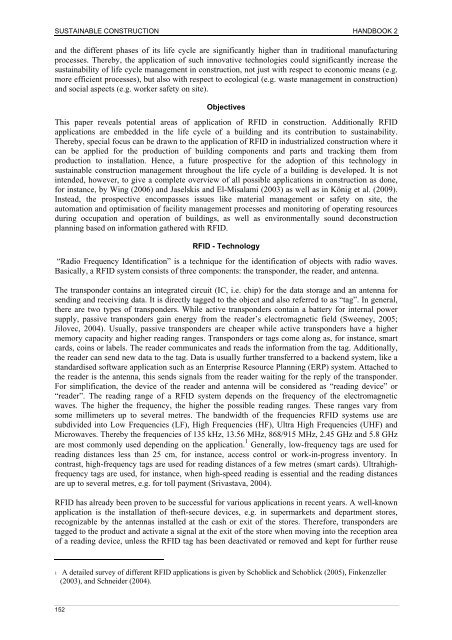Industrialised, Integrated, Intelligent sustainable Construction - I3con
Industrialised, Integrated, Intelligent sustainable Construction - I3con
Industrialised, Integrated, Intelligent sustainable Construction - I3con
You also want an ePaper? Increase the reach of your titles
YUMPU automatically turns print PDFs into web optimized ePapers that Google loves.
SUSTAINABLE CONSTRUCTION HANDBOOK 2<br />
and the different phases of its life cycle are significantly higher than in traditional manufacturing<br />
processes. Thereby, the application of such innovative technologies could significantly increase the<br />
sustainability of life cycle management in construction, not just with respect to economic means (e.g.<br />
more efficient processes), but also with respect to ecological (e.g. waste management in construction)<br />
and social aspects (e.g. worker safety on site).<br />
152<br />
Objectives<br />
This paper reveals potential areas of application of RFID in construction. Additionally RFID<br />
applications are embedded in the life cycle of a building and its contribution to sustainability.<br />
Thereby, special focus can be drawn to the application of RFID in industrialized construction where it<br />
can be applied for the production of building components and parts and tracking them from<br />
production to installation. Hence, a future prospective for the adoption of this technology in<br />
<strong>sustainable</strong> construction management throughout the life cycle of a building is developed. It is not<br />
intended, however, to give a complete overview of all possible applications in construction as done,<br />
for instance, by Wing (2006) and Jaselskis and El-Misalami (2003) as well as in König et al. (2009).<br />
Instead, the prospective encompasses issues like material management or safety on site, the<br />
automation and optimisation of facility management processes and monitoring of operating resources<br />
during occupation and operation of buildings, as well as environmentally sound deconstruction<br />
planning based on information gathered with RFID.<br />
RFID - Technology<br />
“Radio Frequency Identification” is a technique for the identification of objects with radio waves.<br />
Basically, a RFID system consists of three components: the transponder, the reader, and antenna.<br />
The transponder contains an integrated circuit (IC, i.e. chip) for the data storage and an antenna for<br />
sending and receiving data. It is directly tagged to the object and also referred to as “tag”. In general,<br />
there are two types of transponders. While active transponders contain a battery for internal power<br />
supply, passive transponders gain energy from the reader’s electromagnetic field (Sweeney, 2005;<br />
Jilovec, 2004). Usually, passive transponders are cheaper while active transponders have a higher<br />
memory capacity and higher reading ranges. Transponders or tags come along as, for instance, smart<br />
cards, coins or labels. The reader communicates and reads the information from the tag. Additionally,<br />
the reader can send new data to the tag. Data is usually further transferred to a backend system, like a<br />
standardised software application such as an Enterprise Resource Planning (ERP) system. Attached to<br />
the reader is the antenna, this sends signals from the reader waiting for the reply of the transponder.<br />
For simplification, the device of the reader and antenna will be considered as “reading device” or<br />
“reader”. The reading range of a RFID system depends on the frequency of the electromagnetic<br />
waves. The higher the frequency, the higher the possible reading ranges. These ranges vary from<br />
some millimeters up to several metres. The bandwidth of the frequencies RFID systems use are<br />
subdivided into Low Frequencies (LF), High Frequencies (HF), Ultra High Frequencies (UHF) and<br />
Microwaves. Thereby the frequencies of 135 kHz, 13.56 MHz, 868/915 MHz, 2.45 GHz and 5.8 GHz<br />
are most commonly used depending on the application. 1 Generally, low-frequency tags are used for<br />
reading distances less than 25 cm, for instance, access control or work-in-progress inventory. In<br />
contrast, high-frequency tags are used for reading distances of a few metres (smart cards). Ultrahighfrequency<br />
tags are used, for instance, when high-speed reading is essential and the reading distances<br />
are up to several metres, e.g. for toll payment (Srivastava, 2004).<br />
RFID has already been proven to be successful for various applications in recent years. A well-known<br />
application is the installation of theft-secure devices, e.g. in supermarkets and department stores,<br />
recognizable by the antennas installed at the cash or exit of the stores. Therefore, transponders are<br />
tagged to the product and activate a signal at the exit of the store when moving into the reception area<br />
of a reading device, unless the RFID tag has been deactivated or removed and kept for further reuse<br />
1 A detailed survey of different RFID applications is given by Schoblick and Schoblick (2005), Finkenzeller<br />
(2003), and Schneider (2004).






